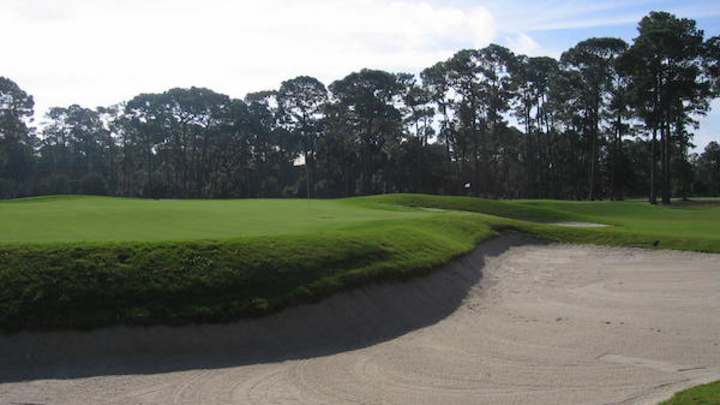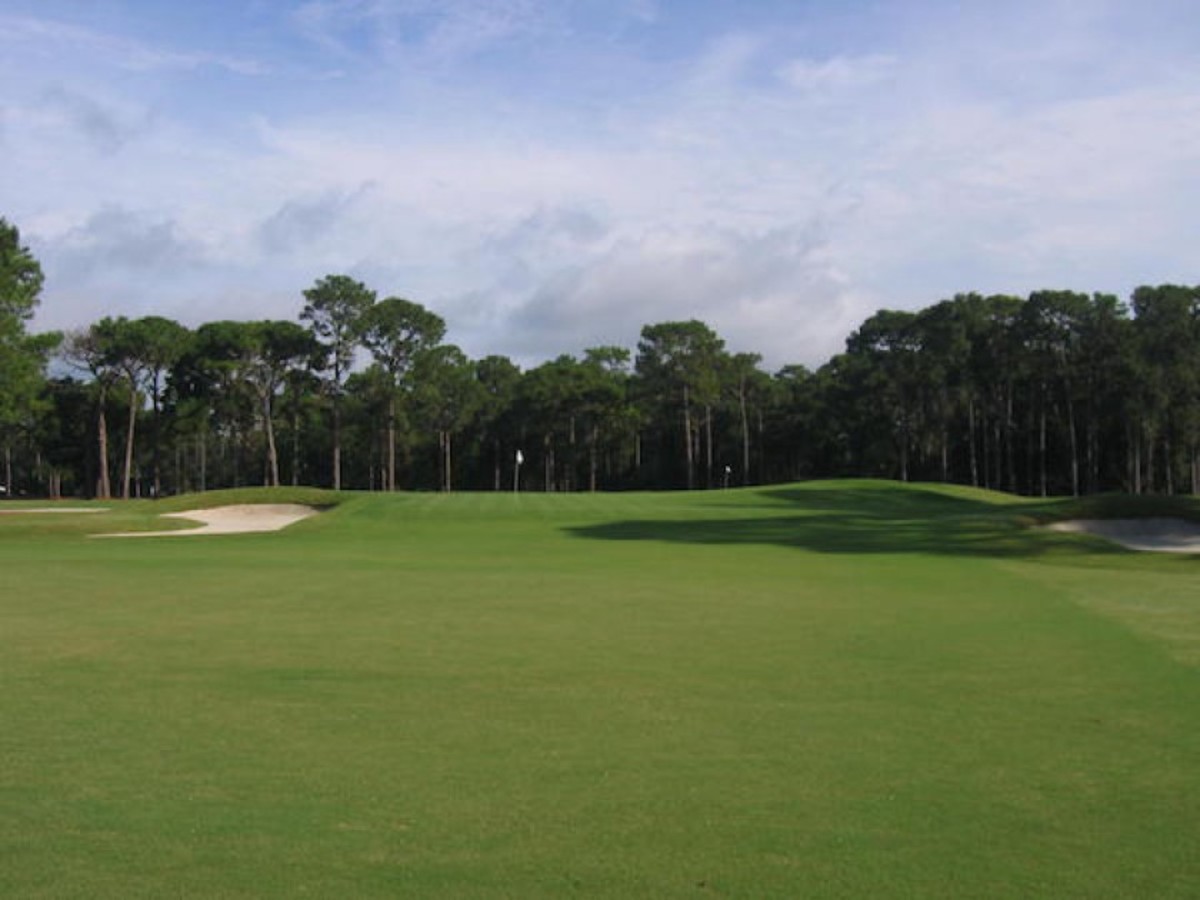Rare Ross writings bring Brunswick's renewal

Mike Fay could never make it as an action-film star because, well, he doesn’t exactly pull a punch.
“It was a mess,” said Fay, a 1989 founder of the Donald Ross Society. “It was on the last rung of the ladder and ready to fall into the [outhouse hole] altogether.”
That was circa 2005 and his immediate impression upon first visiting the Ross-designed Brunswick Country Club, situated along a 100-mile Atlantic Coast stretch in Georgia’s Golden Isles.
Fay had been invited by a member who told him he had the original course plans. Fay left in disbelief.
Brunswick Country Club, established in 1920, had little going for it. By Ross standards, think the Rodney Dangerfield of golf courses. An aging woe. It lent to something those insufferable hackers, The Three Stooges, might have championed. The clubhouse was ramshackle. Cart paths had been installed piecemeal and inconsistent throughout.
And the greens. Oh, the greens. They had been over-seeded for years, while the accumulation of sand and top dressing certainly didn’t help. They had been plugged and filled more times than a frequently infected Eustachian tube.
As a result, the green complexes had raised anywhere between 12-18 inches. Instead of turtle-shell greens, they looked more like misshapen upside down saucers and were no bigger than 15-20 feet in diameter.
“At that point I had seen about 250 Ross courses and none of those courses were like this,” said Fay, retired and now captain emeritus of the society. “I’m looking at this thing and I’m thinking, ‘This is about the worse thing I have ever seen.’”
It’s near incomprehensible that a course could go almost 70 years without a renovation, but that’s part of Brunswick’s pathos. In hindsight, it’s a pretty good return on investment – at the expense of nearly becoming golf’s version of a Greek Tragedy. But don’t be fooled; this is not a sad story. Its phoenix rose from the ashes.
The origins of Brunswick, a founding member of the Georgia State Golf Association, dates back to 1899 on a different property roughly 6 miles south of its current location. In the early 1930s, the club moved to where it is today — still nestled among barrier islands of Sea, St. Simons Island, Little St. Simons Island and Jekyll that offer more than 200 holes to play. The expanse is as close to a golf Mecca as any.
At the time some 80-plus years ago, a golf pro at Sea Island had been commissioned to complete a straightforward nine-hole layout. Nothing fancy. Tees, fairways, square sand greens and no bunkers. Ross entered the picture in March of 1938 and did the back-nine routing. Six months later he returned to rework the front nine. The club paid him $1,000 for two days of work.
Time elapsed. Nature took its toll. The course, like a fading photo, lost its luster.
“Looking at aerial photos from 1953,” said current head golf pro and general manager, Dan Hogan, “you can see how the greens in a 14-year window changed.”
Hogan started at Brunswick in February 2006. About then the club was immersed in a membership drive to privatize. Frankly, it needed new life and Hogan ably monitored its pulse. By mid October, the club had generated enough capital to begin a long-coveted restoration project that also included a new clubhouse. Naturally, strong consensus dictated that Ross’ original designs be followed. The same hand-written plans that had somehow fallen into the hands of multiple people over the years.
Hogan worked on obtaining the drawings in 2006. After acquiring them, he was surprised to find them in a non-descript manila envelope, pretty much untouched. Inside he found an additional drawing of another course, Bellpoint Golf Course, which had long ago resided across the street from Brunswick. Today, a housing project stands in its place.
When Fay arrived to review the course, he didn’t recognize the plans. They were hand written on blank paper. Most Ross designs exist on graph paper, and are succinct, Fay said. Up until five years ago, Tufts Archives at Pinehurst, N.C., had only recognized the back nine being touched by Ross. More research ultimately led to all 18 holes verified as Ross’ work.
“I knew the handwriting of Ellis Maples, Walter Irving Johnson and, of course, Ross,” said Fay, alluding to those who worked for Ross. “These were completely new to me, but they were pretty detailed and accurate. The thing that remains a great mystery is, where did these plans come from?”
Regardless of that question, which may never be answered, what the club needed now were experienced designers who could restore the course.
Enter Davis Love III. When Love moved to St. Simons Island at age 15, he pretty much grew up at Brunswick C.C. He won the long-running Golden Isles Invitational Tournament there in 1985. Additionally, he played high school tournaments at Brunswick C.C. Like colleagues Andy Bean and Steve Melnyk, also course patrons, Love tucked away wistful memories as he progressed to the PGA Tour.
Love remained rooted to the area as he raised his family. His son, Dru Love, would go on to win the Golden Isles Invitational twice. Aside from playing golf, Davis Love III developed Love Golf Design in 1994 with the late Bob Spence. To Hogan, it became a no-brainer that Love’s company had the gravitas to do the job.
The course had good bones, according to Mark Love — Davis Love’s brother — when he first set eyes on it. They were convinced they could take Brunswick off life support.
“It was like taking a ’57 Chevy and rolling it into the shop, knowing that you really can’t screw it up,” said Davis Love III. “There aren’t too many ’57 Chevys left anymore, let alone parts, so we knew we needed to be careful and exact.”
By the end of ’06, the project began. Love Golf Design tackled the par-3, 152-yard fourth hole as its first. It featured a massive bunker across the front of the green complex. The first dig upon the green turned out to be the quintessential find. That’s because the team unearthed the original soil cap.

New tees lengthened the par-72 design to 6,802 yards, but the course, including the opening hole, closely adheres to Ross' intent. [Photo: Brunswick Country Club]
“It was very much like an archaeological dig,” said Hogan, adding that at one point they found horse shoes buried deep within. “I’ll never forget it. When they were rough shaping that green, Mark looked at the group and said, ‘This is the best green we’ve ever built and it’s not even our design.’”
From that point, they cored out each complex, put in the greens mix and floated them out to match the drawings. Love’s team went as deep as 4 feet on grassed-down bunkers and stayed true to Ross’ routing.
“On Ross’ greens notes, the notations and elevations were all there,” said Davis Love III. “I felt a lot better once we got the first green finished and knew we’d be able to restore the course exactly to Ross’ design.”
Added Hogan: “Their design philosophy is ‘less is more’ and it really paid off here. There wasn’t a lot left for interpretation.”
Ross’ signature traits on the more than 350 courses he designed — crowned greens that contain fall-away slopes, undulating contours and unreceptive to poor approach shots — certainly applied to Brunswick C.C. Each hole was predicated on naturalness or what the flat land offered. Another one of his signatures — building from back greens to back tees — was evident.
The elevation change might be 6 inches at most. Another Ross trademark lay in his routing. Perhaps no other architect ever routed a course as well as Ross, said Fay.
Davis Love III saw Ross’ skill and imagination bubble to the forefront as holes were completed. Love Golf Design replicated everything in the plans, all the way to greens gradient and contours. No green resembles another and every type of break comes into play.
Davis Love III would appear intermittently, as time allotted due to his PGA Tour schedule, while Mark Love handled most of the day-to-day operations. But Davis Love chuckled to himself as he saw the course molding into shape. He’d wander back to his high school days and emulate shots in his head. Many approaches ended up in abnormal collection areas short of the greens.
“It explained why I was always coming up short of the greens,” laughed Davis Love III. “The greens back then were tiny. Over time the weather and other factors eroded the greens to the point where there wasn’t much left.”
After 12 arduous months, the project was completed. The club reopened in 2007 to a membership of 375 patrons. Hogan said that over the last 100 days in 2006, more than 200 people committed — knowing the course would be closed for a year. While the course is private, the club offers nine membership levels, including non-resident, winter and seasonal.
On a tangential note, construction on a new 14,000 square-foot clubhouse had also began. The 2008 recession and two hurricanes caused hiccups, but Hogan saw it through. The course renovation and clubhouse cost close to $6.5 million.
Since the renovation, the course has received rave reviews. Davis Love III called it one of his “go-to courses.”
New tees lengthened the par-72 design to 6,802 yards, which stands out as its championship setup. Overall, there are now six sets of tees where the course plays anywhere from 6,437 yards to 4,861 yards. A 73.1 course rating and slope of 131 make it enjoyable, yet challenging.
Ross Society president Bradford Becken, who has played 358 known Ross courses since 2017, got in a round about a decade ago.
“You had to be patient and happy with par,” he said. “There was a lot going on with the green complexes and bunkering, where you had to think and not over-commit.”
The restored greens also created larger targets, albeit still unforgiving if not tactically careful. Sounds like a Ross green, right?
“They are typical Ross greens,” said Fay, who has made several more visits to Brunswick. “They’re sensible, they’re contiguous, they have plenty of roll and the sizes can handle the length of each hole.”
All of this was a collective sigh of relief to Hogan. He, out of anyone involved in Brunswick’s facelift, knew it would be a monumental undertaking. Looking back, it was more like taking a dirty diamond and polishing it.
“The way I look at it,” said Hogan, “the club got way more bang for the buck with the work Love’s design team did.”
If not for those plans that mysteriously came to light around 2005, who knows, the aforementioned fading photo analogy may have become a reality — with Brunswick Country Club on the precipice of hazily crossing over into mythos.
Today all 18 greens drawings from 1938 are properly matted and framed, showcased in the main hallway of the clubhouse. Hogan said he also sent digital copies to Tuft’s Archives so they’d have a complete set of drawings and other information.
It capped a story that came full circle. Fay credited Hogan with doing a masterful job leading the charge, still amazed by the complete makeover.
“So when you look at it, they got a brand new course, a brand new clubhouse, and they did it working with a set of plans no one knows where they came from,” laughed Fay. “It’s a great story.”
Ken Klavon was the online editor and a senior writer at the U.S. Golf Association for 12 years. He has covered golf for 24 years.
Email:kenklavon@gmail.com
